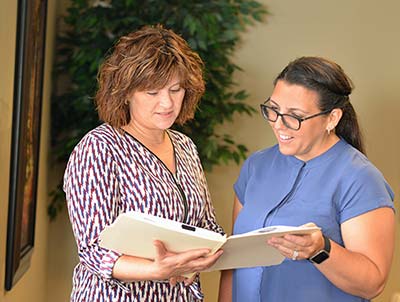Pilot Program Underway
By Susan E. Bouchard
(photographs by Susan E. Bouchard)

Lauren Yabut, left, Administrator at Charlesgate and Kim Gardner, Community Support Specialist review a treatment plan.
Age-Friendly Rhode Island’s Strategic Plan calls for testing new models of supporting older adults in the community. One innovative, grant-funded project currently underway is a pilot program bringing behavioral health services directly into housing.
Partnering with Charlesgate and the Community Care Alliance, this six-month pilot program is closing gaps in care for residents and building bridges of support that extend into the community.
Located in Providence, Charlesgate is an ideal place to test this model because they offer a wide continuum of care with three levels of living – independent, assisted living and nursing home care – already available on their campus.
Adding behavioral health services on-site helps identify problems as they arise. This allows for earlier intervention, prevents situations from escalating and becoming a full-blow crisis. The goal is to reach residents before they reach that crisis point.
Behavioral health issues are on the rise and recognizing the signs is half the battle. According to Charlesgate Administrator Lauren Yabut, prior to the start of the pilot program, like with most housing complexes the staff didn’t have all the resources and training to handle crisis prevention and intervention. Now, with the help of

Gardner chats with residents at Charlesgate.
partner-agency Community Care Alliance, the entire Charlesgate staff is learning to recognize risk factors and warning signs. By teaching non-health professionals the signs of mental health challenges, they can make referrals to the behavioral health staff. Now it is a team effort.
Gardner chats with residents at Charlesgate.
An all-too common scenario might look like this; an elderly woman who has been diagnosed as bipolar and starts slipping into depression. She’s not eating or taking her medication, she’s not going out or taking care of herself. All of this is starting to impact the quality of her life. In the past, the housing staff may have known that something wasn’t quite right, but they didn’t have the training to look at the big picture. Now, not only can they recognize the signs, there is someone there who can help.
Enter Community Support Specialist Kim Gardner. With behavioral-health services on-site, one quick referral to Gardner and she can check in with the resident and best figure out how to help them. Gardner has the skills and  the training to help get the resident back on track. She is there to help, not to diagnose them. She can offer a range of coping skills, she can coordinate with their doctor and recommend a review of their medications, and if the resident does require hospitalization, Gardner can create a plan for when they return home. Closing the gaps in care and improving their quality of life.
the training to help get the resident back on track. She is there to help, not to diagnose them. She can offer a range of coping skills, she can coordinate with their doctor and recommend a review of their medications, and if the resident does require hospitalization, Gardner can create a plan for when they return home. Closing the gaps in care and improving their quality of life.
Part of what makes Gardner so effective, Yabut explains, is that she doesn’t sit behind a desk waiting for people to come to see her. She walks through the halls, chatting with residents and getting to know them. Being accessible helps her identify who needs help, how much and when.
Gardner offers, “I love having that interaction with the residents, having that one-on- one time. They just want someone to hear them, they’re looking for someone to talk to I can go to them or they can come to me.”
On-site care improves residents’ quality of life. Early indications also show that having someone with an understanding of the larger mental health community in the mix is saving money through reduced calls to police and fire and fewer hospitalizations.
Stay tuned.
